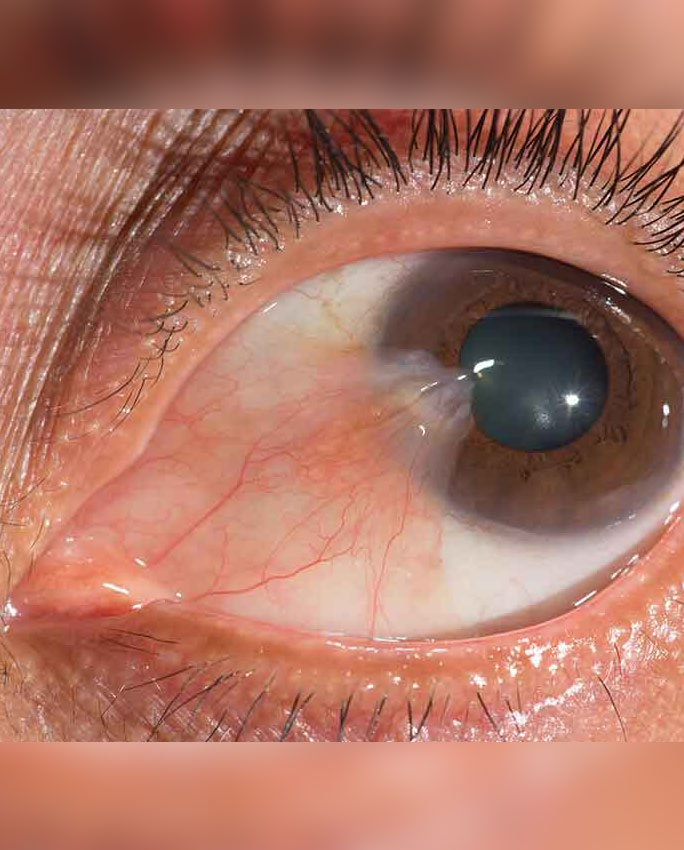WHAT IS A PTERYGIUM (SURFER’S EYE)?
A pterygium is a growth that appears on the thin, clear membrane on the surface of the eye (known as the conjunctiva), and which gradually extends on the cornea. It is not cancerous and it doesn’t affect other parts of the body, but if it spreads too far across the eye and over the pupil, a pterygium can ultimately affect your vision.
Pterygia generally grows outwards from the inner corner of the eye (although it can spread from the outer edge, or from both sides at once, although this is rare). A pterygium can grow in one or both eyes at the same time.
Not everyone experiences pterygium symptoms, but an eye with pterygium can feel sore and irritated, making it look red and inflamed. An eye specialist will generally be able to identify the condition through observing the eye’s appearance, rather than through conducting any specific tests.
WHAT IS PTERYGIUM SURGERY?
Pterygium surgery is a surgical procedure performed to remove the growth/scar tissue that grows over the cornea (the clear window of the eye), and which can grow across the pupil and cause permanent scarring, affecting vision.
There are different techniques for pterygium removal and these have been refined over time in order to prevent regrowth and recurring pterygium symptoms (although this can not always be entirely ruled out).
There are also steps that can be taken to prevent or limit the onset of pterygium symptoms (also known as surfer’s eye), such as using lubricating eye drops, avoiding UV light exposure, and wearing protective sunglasses, but in most cases pterygium surgery will ultimately be required.
PTERYGIUM – WHAT CAUSES IT?
There are a number of common pterygium causes, and it is estimated that around 1 in 100 people in Australia develop the condition. It is very often the result of exposure to sunlight and ultraviolet radiation (which is why it is also referred to as surfer’s eye), while dusty and windy environments can also have an impact.
WHAT ARE COMMON PTERYGIUM SYMPTOMS?
If the fine blood vessels in your eye become visible, or you notice a pink, triangular tissue beginning to grow on the surface of the eye, then it is likely that a pterygium is developing. You may also notice that you have an itching or gritty sensation on the surface of the eye.
IS PTERYGIUM TREATMENT IN ADELAIDE AVAILABLE?
The treatment options open to you will depend on the extent and severity of the pterygium growth. In the initial stages, your ophthalmologist may recommend pterygium treatment without surgery, suggesting that you avoid exposure to sunlight and UV light as far as possible, or prescribing eye drops to soothe and lubricate the surface of the eye. In some instances, pterygia may even be left untreated, although regular eye checks will be required.
However, in most cases pterygium removal will ultimately be the course of action recommended by your ophthalmologist.
The aim of pterygium surgery is to remove any growth before it can spread and cover the cornea (the clear window of the eye). The procedure will also prevent the cornea from becoming scarred, which can ultimately cause permanent problems with vision.
Pterygium surgery in Adelaide is a relatively simple procedure that can usually be performed as day surgery under local anaesthetic, and involves removing the abnormal tissue from the sclera and cornea of the eye. There are minimal risks with the surgery, and in most cases the pterygium surgery recovery time will be relatively swift and uncomplicated (provided you follow some simple guidelines).
In a relatively small number of cases, a pterygium can return after it has been surgically removed, although the possibility of this can be reduced through a small conjunctival graft being taken from under the upper eyelid and secured into the bed of the pterygium.
BOOK AN APPOINTMENT

FREQUENTLY ASKED QUESTIONS - Pterygium
You can reduce or slow their growth by wearing sunglasses and avoiding sunlight and UV rays as much as possible, while also staying out of windy and dusty environments as much as you can.
Whether or not you can wear contact lenses with pterygia will depend on the size and development of the growth. Your ophthalmologist will provide you with guidance based on your specific circumstances.
Pterygium is highly unlikely to lead to or result in blindness, although if left untreated the condition can significantly impact on the quality of your vision.
While there are no methods for entirely getting rid of pterygium naturally, in some cases it can be left untreated with no need for pterygium surgery. You may also be prescribed eye drops as a means of reducing the effect of pterygium symptoms.
Generally speaking, recovery from pterygium surgery will take up to 2 weeks, after which time you should be able to return to work and resume your regular lifestyle activities. However, it may be up to 4 weeks before you can swim again.
Your Adelaide ophthalmologist will be able to advise you more specifically, but there are some general tips to follow after pterygium surgery:
- You should not swim for about a month after surgery;
- You may find it tricky to drive for the first week, so this should be avoided;
- You may need to take up to two weeks off work;
- You will likely need to use antibiotic and anti-inflammatory eye drops; and
- You might need to change your glasses prescription.
